Introduction to Business Law Common Law Assignment
VerifiedAdded on 2023/06/15
|8
|2043
|413
AI Summary
This Common Law Assignment discusses the applicability of various case laws to the given case study on Introduction to Business Law. It covers topics like elements of contract, implied and expressed terms, breach of warranty, and exclusion clauses.
Contribute Materials
Your contribution can guide someone’s learning journey. Share your
documents today.
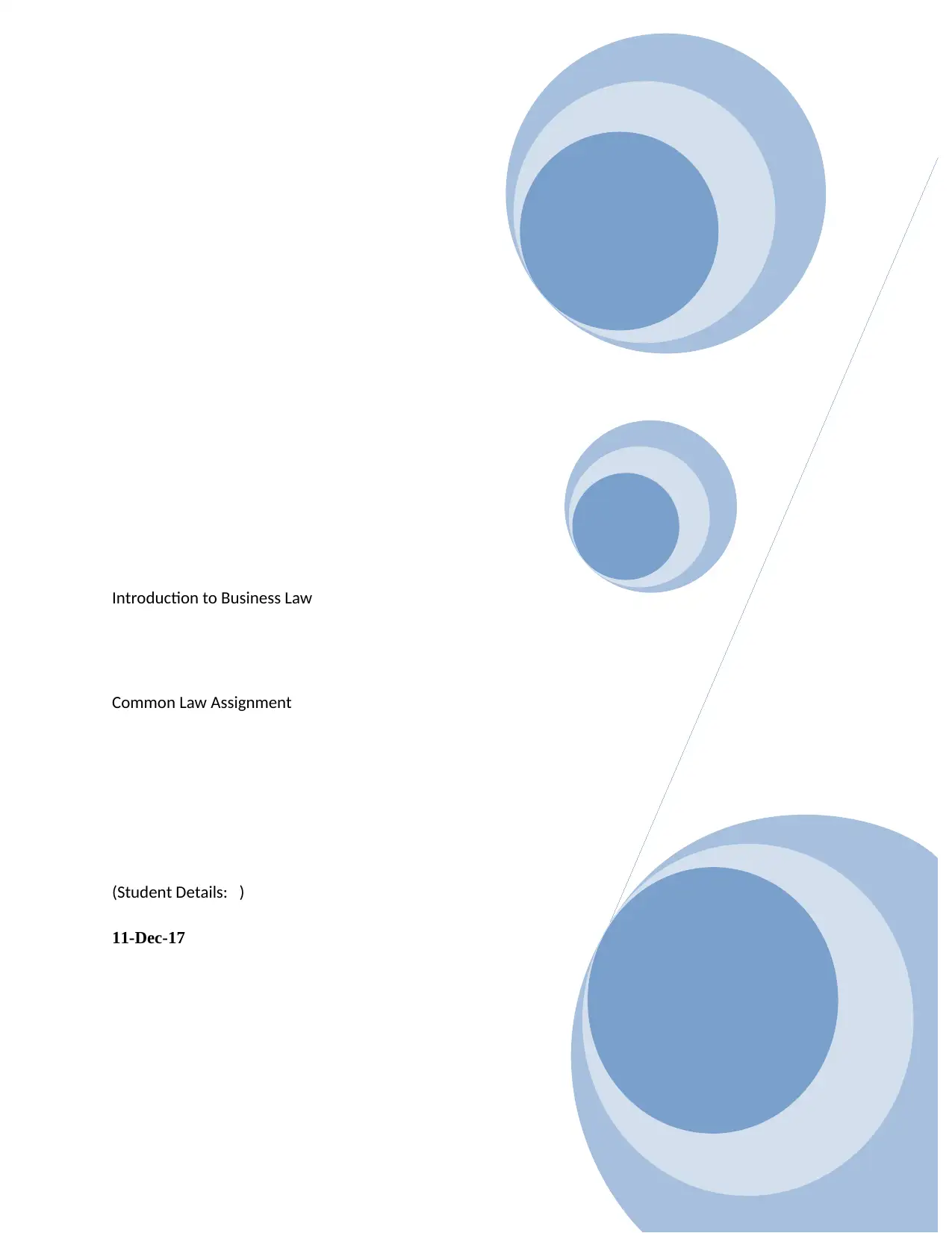
Introduction to Business Law
Common Law Assignment
(Student Details: )
11-Dec-17
Common Law Assignment
(Student Details: )
11-Dec-17
Secure Best Marks with AI Grader
Need help grading? Try our AI Grader for instant feedback on your assignments.
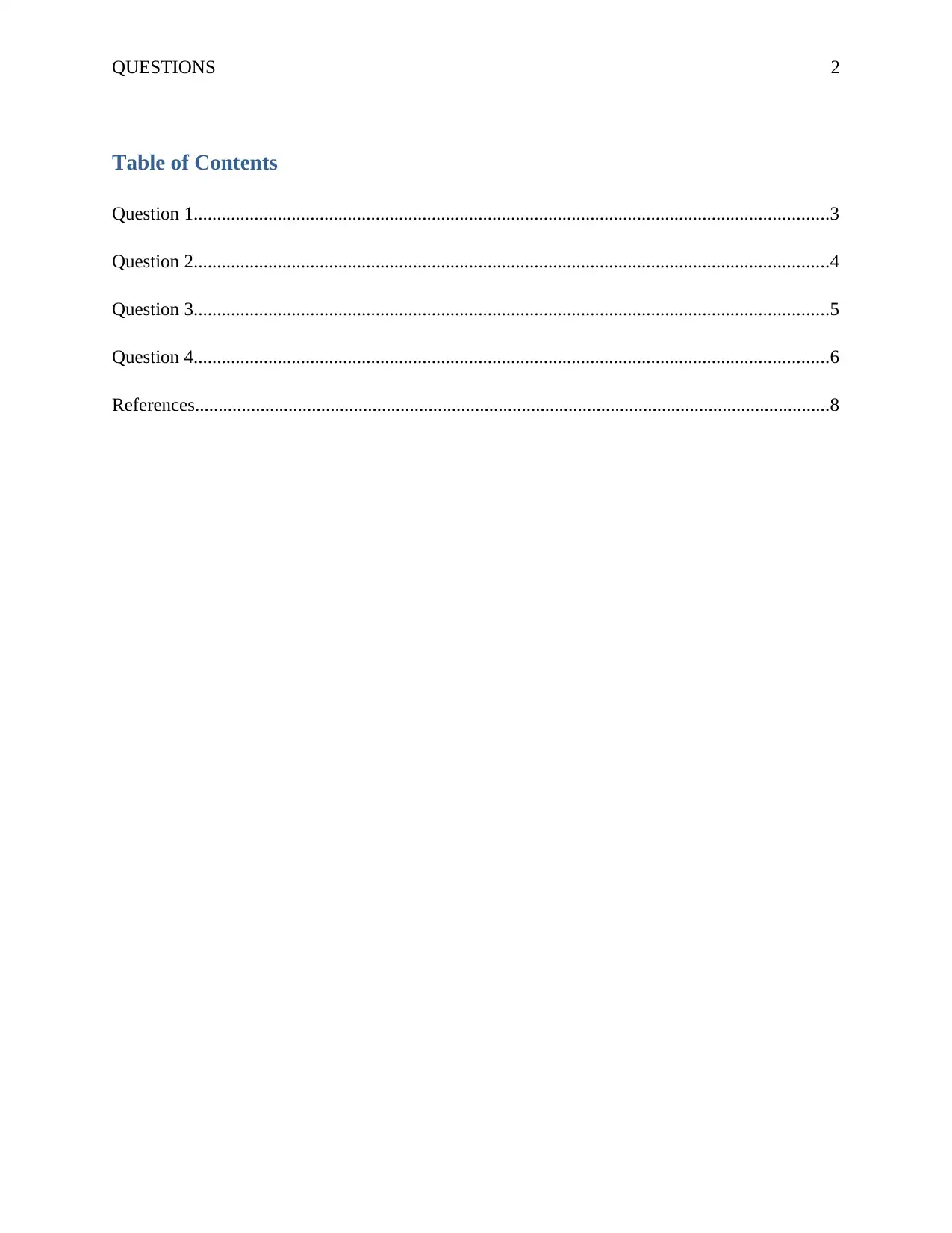
QUESTIONS 2
Table of Contents
Question 1........................................................................................................................................3
Question 2........................................................................................................................................4
Question 3........................................................................................................................................5
Question 4........................................................................................................................................6
References........................................................................................................................................8
Table of Contents
Question 1........................................................................................................................................3
Question 2........................................................................................................................................4
Question 3........................................................................................................................................5
Question 4........................................................................................................................................6
References........................................................................................................................................8
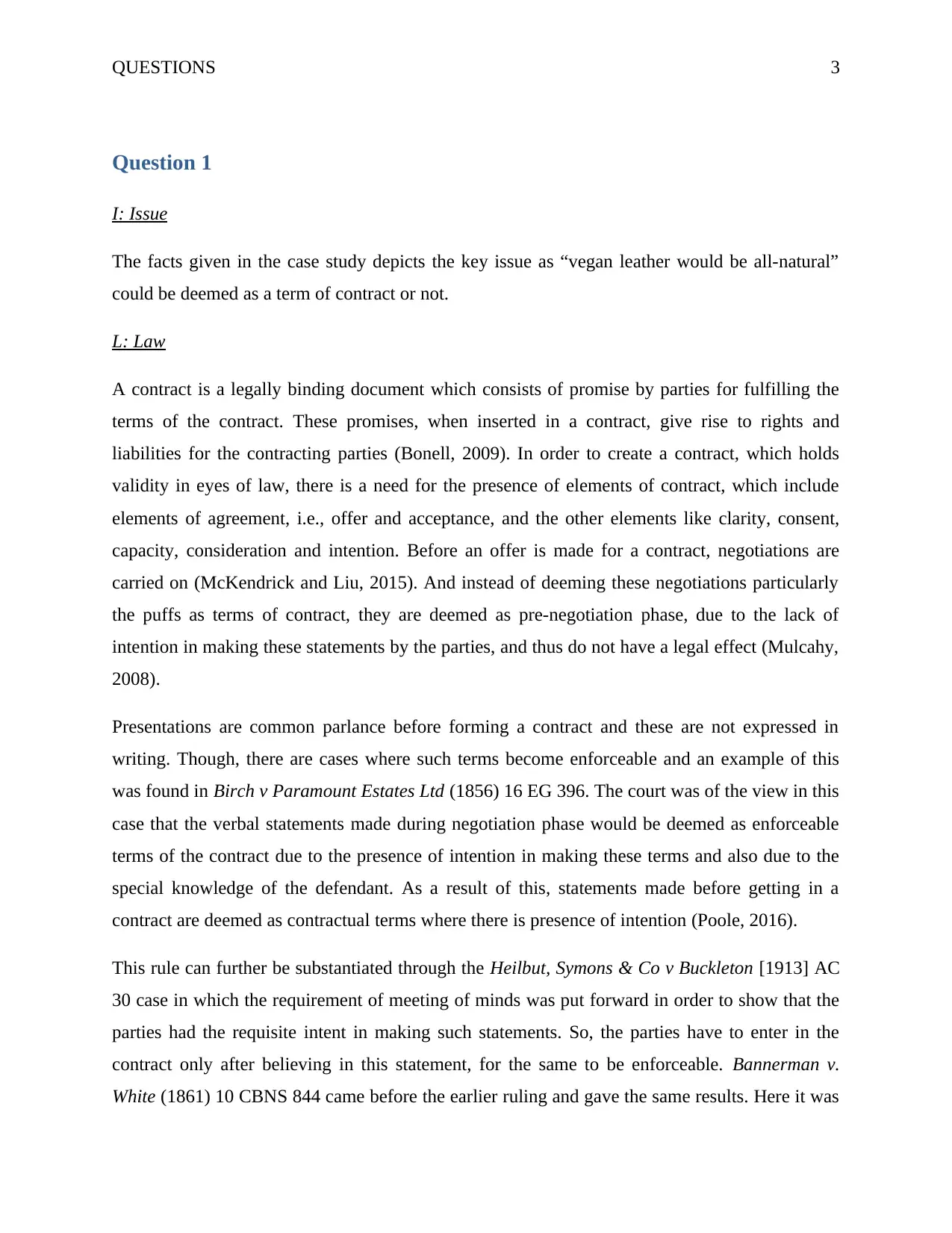
QUESTIONS 3
Question 1
I: Issue
The facts given in the case study depicts the key issue as “vegan leather would be all-natural”
could be deemed as a term of contract or not.
L: Law
A contract is a legally binding document which consists of promise by parties for fulfilling the
terms of the contract. These promises, when inserted in a contract, give rise to rights and
liabilities for the contracting parties (Bonell, 2009). In order to create a contract, which holds
validity in eyes of law, there is a need for the presence of elements of contract, which include
elements of agreement, i.e., offer and acceptance, and the other elements like clarity, consent,
capacity, consideration and intention. Before an offer is made for a contract, negotiations are
carried on (McKendrick and Liu, 2015). And instead of deeming these negotiations particularly
the puffs as terms of contract, they are deemed as pre-negotiation phase, due to the lack of
intention in making these statements by the parties, and thus do not have a legal effect (Mulcahy,
2008).
Presentations are common parlance before forming a contract and these are not expressed in
writing. Though, there are cases where such terms become enforceable and an example of this
was found in Birch v Paramount Estates Ltd (1856) 16 EG 396. The court was of the view in this
case that the verbal statements made during negotiation phase would be deemed as enforceable
terms of the contract due to the presence of intention in making these terms and also due to the
special knowledge of the defendant. As a result of this, statements made before getting in a
contract are deemed as contractual terms where there is presence of intention (Poole, 2016).
This rule can further be substantiated through the Heilbut, Symons & Co v Buckleton [1913] AC
30 case in which the requirement of meeting of minds was put forward in order to show that the
parties had the requisite intent in making such statements. So, the parties have to enter in the
contract only after believing in this statement, for the same to be enforceable. Bannerman v.
White (1861) 10 CBNS 844 came before the earlier ruling and gave the same results. Here it was
Question 1
I: Issue
The facts given in the case study depicts the key issue as “vegan leather would be all-natural”
could be deemed as a term of contract or not.
L: Law
A contract is a legally binding document which consists of promise by parties for fulfilling the
terms of the contract. These promises, when inserted in a contract, give rise to rights and
liabilities for the contracting parties (Bonell, 2009). In order to create a contract, which holds
validity in eyes of law, there is a need for the presence of elements of contract, which include
elements of agreement, i.e., offer and acceptance, and the other elements like clarity, consent,
capacity, consideration and intention. Before an offer is made for a contract, negotiations are
carried on (McKendrick and Liu, 2015). And instead of deeming these negotiations particularly
the puffs as terms of contract, they are deemed as pre-negotiation phase, due to the lack of
intention in making these statements by the parties, and thus do not have a legal effect (Mulcahy,
2008).
Presentations are common parlance before forming a contract and these are not expressed in
writing. Though, there are cases where such terms become enforceable and an example of this
was found in Birch v Paramount Estates Ltd (1856) 16 EG 396. The court was of the view in this
case that the verbal statements made during negotiation phase would be deemed as enforceable
terms of the contract due to the presence of intention in making these terms and also due to the
special knowledge of the defendant. As a result of this, statements made before getting in a
contract are deemed as contractual terms where there is presence of intention (Poole, 2016).
This rule can further be substantiated through the Heilbut, Symons & Co v Buckleton [1913] AC
30 case in which the requirement of meeting of minds was put forward in order to show that the
parties had the requisite intent in making such statements. So, the parties have to enter in the
contract only after believing in this statement, for the same to be enforceable. Bannerman v.
White (1861) 10 CBNS 844 came before the earlier ruling and gave the same results. Here it was
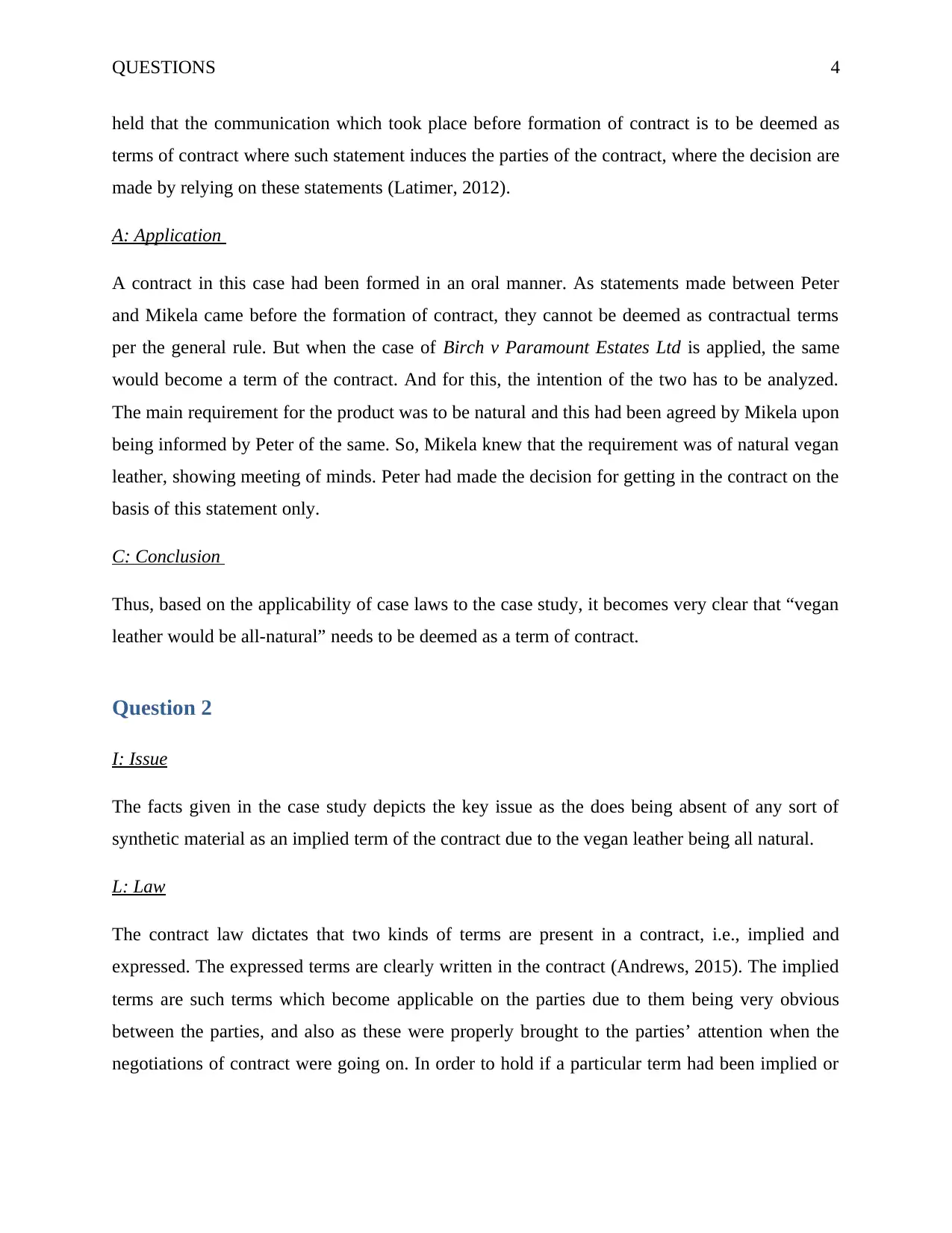
QUESTIONS 4
held that the communication which took place before formation of contract is to be deemed as
terms of contract where such statement induces the parties of the contract, where the decision are
made by relying on these statements (Latimer, 2012).
A: Application
A contract in this case had been formed in an oral manner. As statements made between Peter
and Mikela came before the formation of contract, they cannot be deemed as contractual terms
per the general rule. But when the case of Birch v Paramount Estates Ltd is applied, the same
would become a term of the contract. And for this, the intention of the two has to be analyzed.
The main requirement for the product was to be natural and this had been agreed by Mikela upon
being informed by Peter of the same. So, Mikela knew that the requirement was of natural vegan
leather, showing meeting of minds. Peter had made the decision for getting in the contract on the
basis of this statement only.
C: Conclusion
Thus, based on the applicability of case laws to the case study, it becomes very clear that “vegan
leather would be all-natural” needs to be deemed as a term of contract.
Question 2
I: Issue
The facts given in the case study depicts the key issue as the does being absent of any sort of
synthetic material as an implied term of the contract due to the vegan leather being all natural.
L: Law
The contract law dictates that two kinds of terms are present in a contract, i.e., implied and
expressed. The expressed terms are clearly written in the contract (Andrews, 2015). The implied
terms are such terms which become applicable on the parties due to them being very obvious
between the parties, and also as these were properly brought to the parties’ attention when the
negotiations of contract were going on. In order to hold if a particular term had been implied or
held that the communication which took place before formation of contract is to be deemed as
terms of contract where such statement induces the parties of the contract, where the decision are
made by relying on these statements (Latimer, 2012).
A: Application
A contract in this case had been formed in an oral manner. As statements made between Peter
and Mikela came before the formation of contract, they cannot be deemed as contractual terms
per the general rule. But when the case of Birch v Paramount Estates Ltd is applied, the same
would become a term of the contract. And for this, the intention of the two has to be analyzed.
The main requirement for the product was to be natural and this had been agreed by Mikela upon
being informed by Peter of the same. So, Mikela knew that the requirement was of natural vegan
leather, showing meeting of minds. Peter had made the decision for getting in the contract on the
basis of this statement only.
C: Conclusion
Thus, based on the applicability of case laws to the case study, it becomes very clear that “vegan
leather would be all-natural” needs to be deemed as a term of contract.
Question 2
I: Issue
The facts given in the case study depicts the key issue as the does being absent of any sort of
synthetic material as an implied term of the contract due to the vegan leather being all natural.
L: Law
The contract law dictates that two kinds of terms are present in a contract, i.e., implied and
expressed. The expressed terms are clearly written in the contract (Andrews, 2015). The implied
terms are such terms which become applicable on the parties due to them being very obvious
between the parties, and also as these were properly brought to the parties’ attention when the
negotiations of contract were going on. In order to hold if a particular term had been implied or
Secure Best Marks with AI Grader
Need help grading? Try our AI Grader for instant feedback on your assignments.
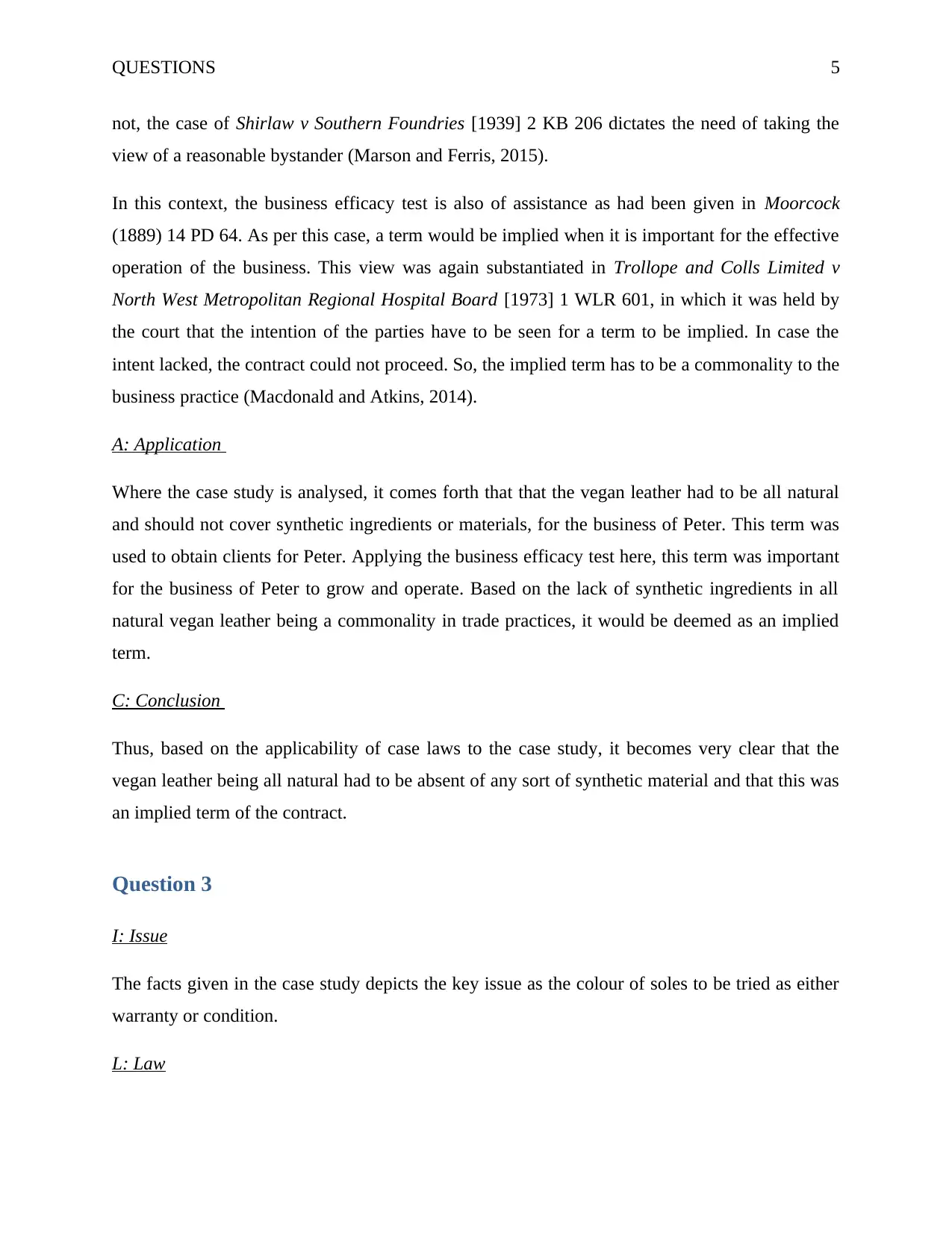
QUESTIONS 5
not, the case of Shirlaw v Southern Foundries [1939] 2 KB 206 dictates the need of taking the
view of a reasonable bystander (Marson and Ferris, 2015).
In this context, the business efficacy test is also of assistance as had been given in Moorcock
(1889) 14 PD 64. As per this case, a term would be implied when it is important for the effective
operation of the business. This view was again substantiated in Trollope and Colls Limited v
North West Metropolitan Regional Hospital Board [1973] 1 WLR 601, in which it was held by
the court that the intention of the parties have to be seen for a term to be implied. In case the
intent lacked, the contract could not proceed. So, the implied term has to be a commonality to the
business practice (Macdonald and Atkins, 2014).
A: Application
Where the case study is analysed, it comes forth that that the vegan leather had to be all natural
and should not cover synthetic ingredients or materials, for the business of Peter. This term was
used to obtain clients for Peter. Applying the business efficacy test here, this term was important
for the business of Peter to grow and operate. Based on the lack of synthetic ingredients in all
natural vegan leather being a commonality in trade practices, it would be deemed as an implied
term.
C: Conclusion
Thus, based on the applicability of case laws to the case study, it becomes very clear that the
vegan leather being all natural had to be absent of any sort of synthetic material and that this was
an implied term of the contract.
Question 3
I: Issue
The facts given in the case study depicts the key issue as the colour of soles to be tried as either
warranty or condition.
L: Law
not, the case of Shirlaw v Southern Foundries [1939] 2 KB 206 dictates the need of taking the
view of a reasonable bystander (Marson and Ferris, 2015).
In this context, the business efficacy test is also of assistance as had been given in Moorcock
(1889) 14 PD 64. As per this case, a term would be implied when it is important for the effective
operation of the business. This view was again substantiated in Trollope and Colls Limited v
North West Metropolitan Regional Hospital Board [1973] 1 WLR 601, in which it was held by
the court that the intention of the parties have to be seen for a term to be implied. In case the
intent lacked, the contract could not proceed. So, the implied term has to be a commonality to the
business practice (Macdonald and Atkins, 2014).
A: Application
Where the case study is analysed, it comes forth that that the vegan leather had to be all natural
and should not cover synthetic ingredients or materials, for the business of Peter. This term was
used to obtain clients for Peter. Applying the business efficacy test here, this term was important
for the business of Peter to grow and operate. Based on the lack of synthetic ingredients in all
natural vegan leather being a commonality in trade practices, it would be deemed as an implied
term.
C: Conclusion
Thus, based on the applicability of case laws to the case study, it becomes very clear that the
vegan leather being all natural had to be absent of any sort of synthetic material and that this was
an implied term of the contract.
Question 3
I: Issue
The facts given in the case study depicts the key issue as the colour of soles to be tried as either
warranty or condition.
L: Law
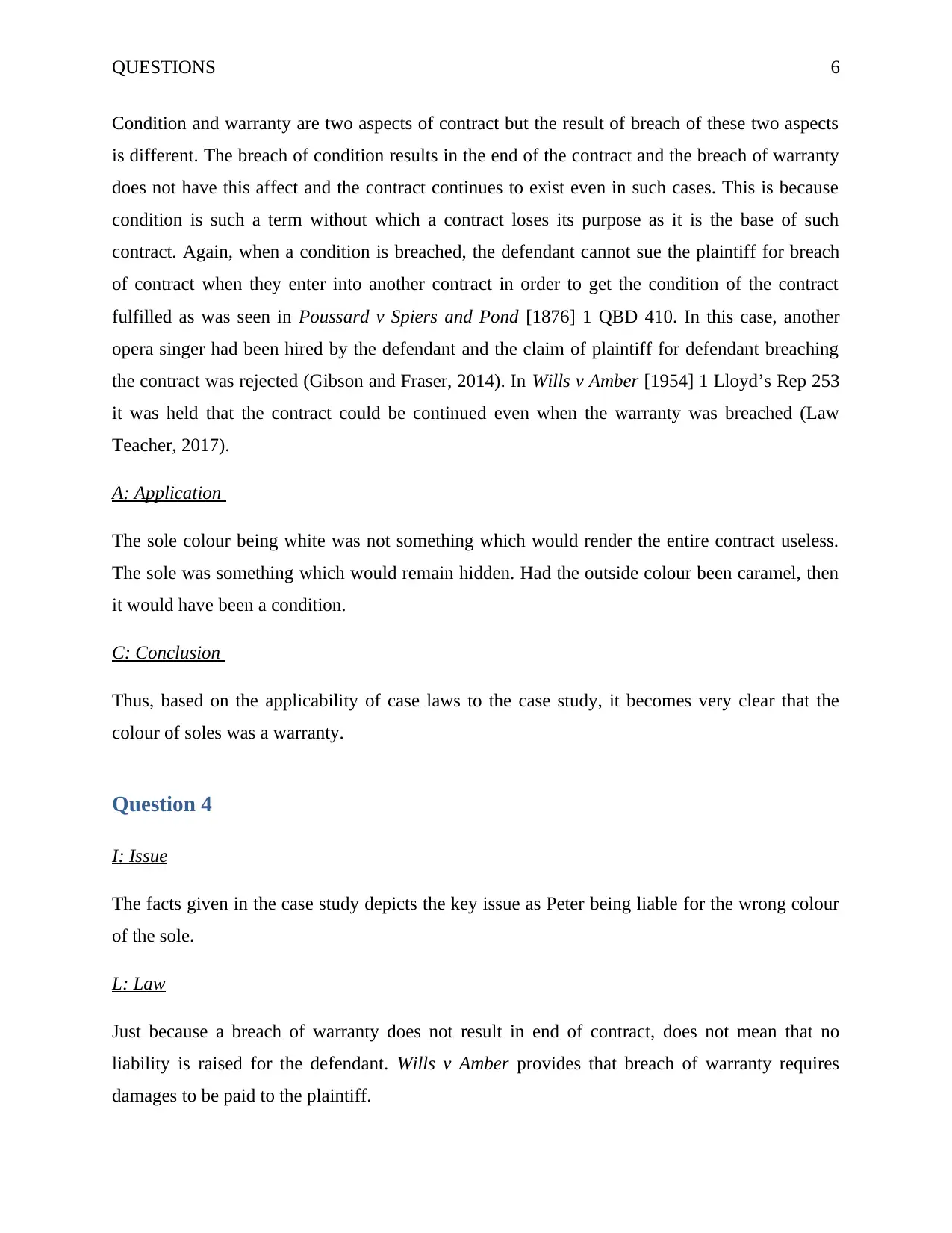
QUESTIONS 6
Condition and warranty are two aspects of contract but the result of breach of these two aspects
is different. The breach of condition results in the end of the contract and the breach of warranty
does not have this affect and the contract continues to exist even in such cases. This is because
condition is such a term without which a contract loses its purpose as it is the base of such
contract. Again, when a condition is breached, the defendant cannot sue the plaintiff for breach
of contract when they enter into another contract in order to get the condition of the contract
fulfilled as was seen in Poussard v Spiers and Pond [1876] 1 QBD 410. In this case, another
opera singer had been hired by the defendant and the claim of plaintiff for defendant breaching
the contract was rejected (Gibson and Fraser, 2014). In Wills v Amber [1954] 1 Lloyd’s Rep 253
it was held that the contract could be continued even when the warranty was breached (Law
Teacher, 2017).
A: Application
The sole colour being white was not something which would render the entire contract useless.
The sole was something which would remain hidden. Had the outside colour been caramel, then
it would have been a condition.
C: Conclusion
Thus, based on the applicability of case laws to the case study, it becomes very clear that the
colour of soles was a warranty.
Question 4
I: Issue
The facts given in the case study depicts the key issue as Peter being liable for the wrong colour
of the sole.
L: Law
Just because a breach of warranty does not result in end of contract, does not mean that no
liability is raised for the defendant. Wills v Amber provides that breach of warranty requires
damages to be paid to the plaintiff.
Condition and warranty are two aspects of contract but the result of breach of these two aspects
is different. The breach of condition results in the end of the contract and the breach of warranty
does not have this affect and the contract continues to exist even in such cases. This is because
condition is such a term without which a contract loses its purpose as it is the base of such
contract. Again, when a condition is breached, the defendant cannot sue the plaintiff for breach
of contract when they enter into another contract in order to get the condition of the contract
fulfilled as was seen in Poussard v Spiers and Pond [1876] 1 QBD 410. In this case, another
opera singer had been hired by the defendant and the claim of plaintiff for defendant breaching
the contract was rejected (Gibson and Fraser, 2014). In Wills v Amber [1954] 1 Lloyd’s Rep 253
it was held that the contract could be continued even when the warranty was breached (Law
Teacher, 2017).
A: Application
The sole colour being white was not something which would render the entire contract useless.
The sole was something which would remain hidden. Had the outside colour been caramel, then
it would have been a condition.
C: Conclusion
Thus, based on the applicability of case laws to the case study, it becomes very clear that the
colour of soles was a warranty.
Question 4
I: Issue
The facts given in the case study depicts the key issue as Peter being liable for the wrong colour
of the sole.
L: Law
Just because a breach of warranty does not result in end of contract, does not mean that no
liability is raised for the defendant. Wills v Amber provides that breach of warranty requires
damages to be paid to the plaintiff.
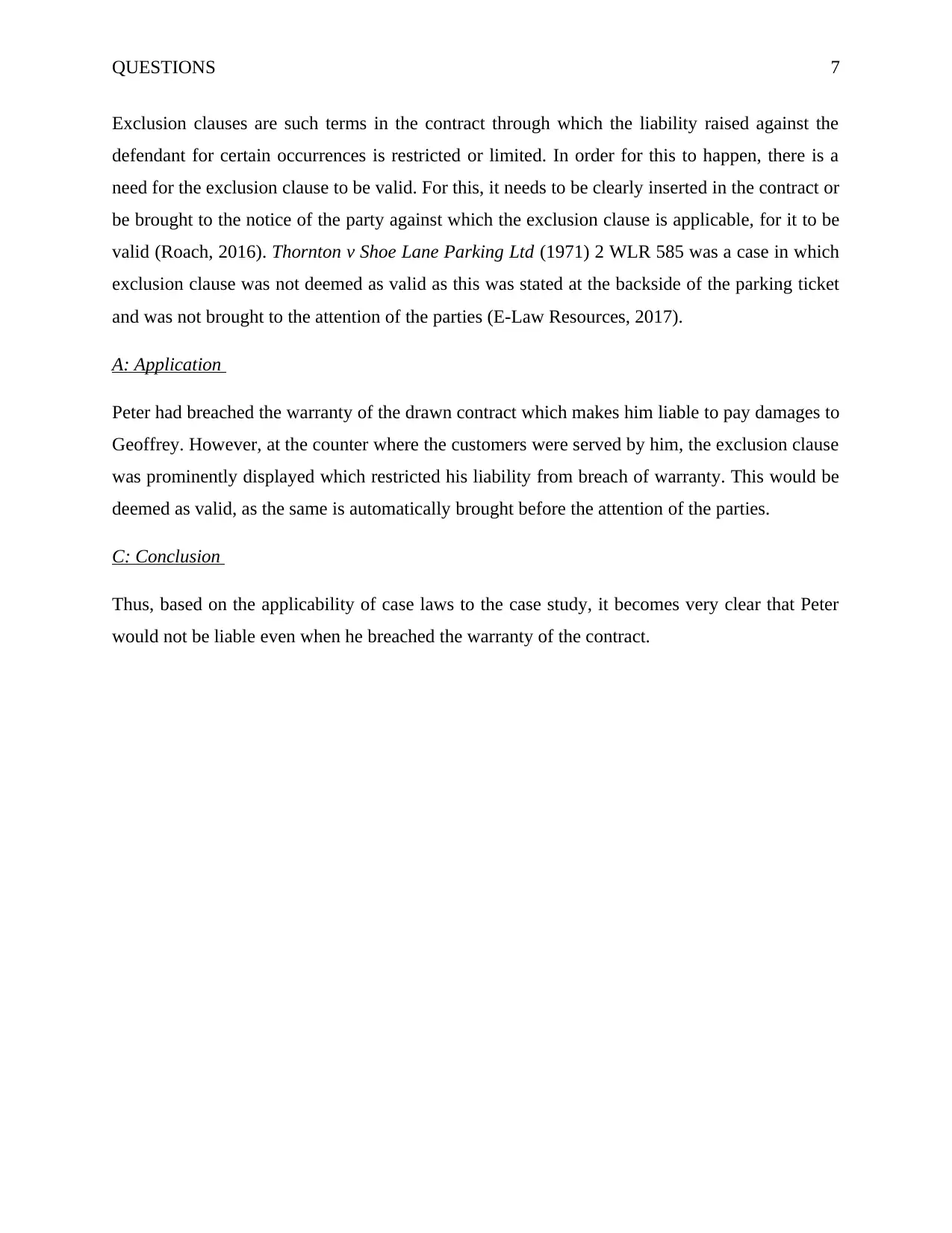
QUESTIONS 7
Exclusion clauses are such terms in the contract through which the liability raised against the
defendant for certain occurrences is restricted or limited. In order for this to happen, there is a
need for the exclusion clause to be valid. For this, it needs to be clearly inserted in the contract or
be brought to the notice of the party against which the exclusion clause is applicable, for it to be
valid (Roach, 2016). Thornton v Shoe Lane Parking Ltd (1971) 2 WLR 585 was a case in which
exclusion clause was not deemed as valid as this was stated at the backside of the parking ticket
and was not brought to the attention of the parties (E-Law Resources, 2017).
A: Application
Peter had breached the warranty of the drawn contract which makes him liable to pay damages to
Geoffrey. However, at the counter where the customers were served by him, the exclusion clause
was prominently displayed which restricted his liability from breach of warranty. This would be
deemed as valid, as the same is automatically brought before the attention of the parties.
C: Conclusion
Thus, based on the applicability of case laws to the case study, it becomes very clear that Peter
would not be liable even when he breached the warranty of the contract.
Exclusion clauses are such terms in the contract through which the liability raised against the
defendant for certain occurrences is restricted or limited. In order for this to happen, there is a
need for the exclusion clause to be valid. For this, it needs to be clearly inserted in the contract or
be brought to the notice of the party against which the exclusion clause is applicable, for it to be
valid (Roach, 2016). Thornton v Shoe Lane Parking Ltd (1971) 2 WLR 585 was a case in which
exclusion clause was not deemed as valid as this was stated at the backside of the parking ticket
and was not brought to the attention of the parties (E-Law Resources, 2017).
A: Application
Peter had breached the warranty of the drawn contract which makes him liable to pay damages to
Geoffrey. However, at the counter where the customers were served by him, the exclusion clause
was prominently displayed which restricted his liability from breach of warranty. This would be
deemed as valid, as the same is automatically brought before the attention of the parties.
C: Conclusion
Thus, based on the applicability of case laws to the case study, it becomes very clear that Peter
would not be liable even when he breached the warranty of the contract.
Paraphrase This Document
Need a fresh take? Get an instant paraphrase of this document with our AI Paraphraser
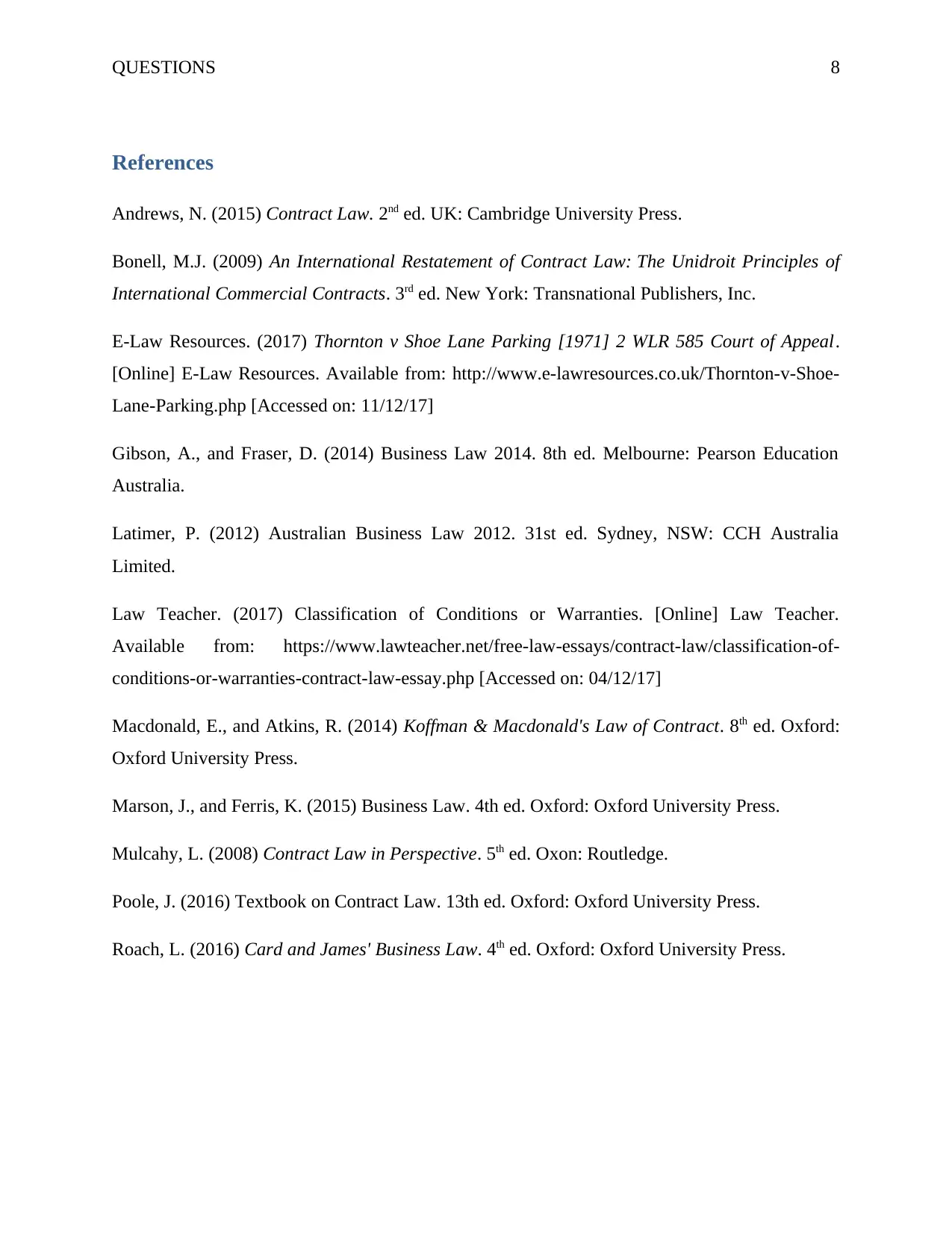
QUESTIONS 8
References
Andrews, N. (2015) Contract Law. 2nd ed. UK: Cambridge University Press.
Bonell, M.J. (2009) An International Restatement of Contract Law: The Unidroit Principles of
International Commercial Contracts. 3rd ed. New York: Transnational Publishers, Inc.
E-Law Resources. (2017) Thornton v Shoe Lane Parking [1971] 2 WLR 585 Court of Appeal.
[Online] E-Law Resources. Available from: http://www.e-lawresources.co.uk/Thornton-v-Shoe-
Lane-Parking.php [Accessed on: 11/12/17]
Gibson, A., and Fraser, D. (2014) Business Law 2014. 8th ed. Melbourne: Pearson Education
Australia.
Latimer, P. (2012) Australian Business Law 2012. 31st ed. Sydney, NSW: CCH Australia
Limited.
Law Teacher. (2017) Classification of Conditions or Warranties. [Online] Law Teacher.
Available from: https://www.lawteacher.net/free-law-essays/contract-law/classification-of-
conditions-or-warranties-contract-law-essay.php [Accessed on: 04/12/17]
Macdonald, E., and Atkins, R. (2014) Koffman & Macdonald's Law of Contract. 8th ed. Oxford:
Oxford University Press.
Marson, J., and Ferris, K. (2015) Business Law. 4th ed. Oxford: Oxford University Press.
Mulcahy, L. (2008) Contract Law in Perspective. 5th ed. Oxon: Routledge.
Poole, J. (2016) Textbook on Contract Law. 13th ed. Oxford: Oxford University Press.
Roach, L. (2016) Card and James' Business Law. 4th ed. Oxford: Oxford University Press.
References
Andrews, N. (2015) Contract Law. 2nd ed. UK: Cambridge University Press.
Bonell, M.J. (2009) An International Restatement of Contract Law: The Unidroit Principles of
International Commercial Contracts. 3rd ed. New York: Transnational Publishers, Inc.
E-Law Resources. (2017) Thornton v Shoe Lane Parking [1971] 2 WLR 585 Court of Appeal.
[Online] E-Law Resources. Available from: http://www.e-lawresources.co.uk/Thornton-v-Shoe-
Lane-Parking.php [Accessed on: 11/12/17]
Gibson, A., and Fraser, D. (2014) Business Law 2014. 8th ed. Melbourne: Pearson Education
Australia.
Latimer, P. (2012) Australian Business Law 2012. 31st ed. Sydney, NSW: CCH Australia
Limited.
Law Teacher. (2017) Classification of Conditions or Warranties. [Online] Law Teacher.
Available from: https://www.lawteacher.net/free-law-essays/contract-law/classification-of-
conditions-or-warranties-contract-law-essay.php [Accessed on: 04/12/17]
Macdonald, E., and Atkins, R. (2014) Koffman & Macdonald's Law of Contract. 8th ed. Oxford:
Oxford University Press.
Marson, J., and Ferris, K. (2015) Business Law. 4th ed. Oxford: Oxford University Press.
Mulcahy, L. (2008) Contract Law in Perspective. 5th ed. Oxon: Routledge.
Poole, J. (2016) Textbook on Contract Law. 13th ed. Oxford: Oxford University Press.
Roach, L. (2016) Card and James' Business Law. 4th ed. Oxford: Oxford University Press.
1 out of 8
Related Documents
Your All-in-One AI-Powered Toolkit for Academic Success.
+13062052269
info@desklib.com
Available 24*7 on WhatsApp / Email
![[object Object]](/_next/static/media/star-bottom.7253800d.svg)
Unlock your academic potential
© 2024 | Zucol Services PVT LTD | All rights reserved.





